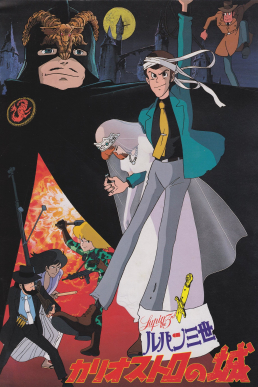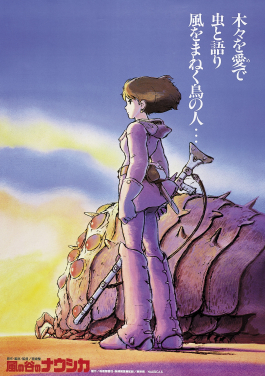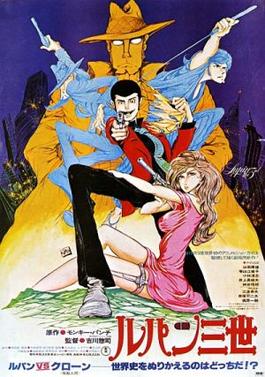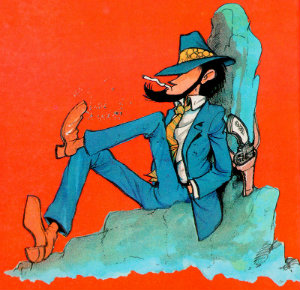
Lupin III: The Castle of Cagliostro is a 1979 Japanese animated action adventure comedy film co-written and directed by Hayao Miyazaki. It is the second animated feature film based on the 1967–69 manga series Lupin III by Monkey Punch. The film was Miyazaki's feature directorial debut after having previously worked as an animator for Toei Animation and Telecom Animation Film, and directing several animated television series, including Lupin III Part I.

Nausicaä of the Valley of the Wind is a 1984 Japanese animated post-apocalyptic fantasy film written and directed by Hayao Miyazaki, based on his 1982–94 manga series of the same name. It was produced by Topcraft and distributed by Toei. Joe Hisaishi, in his first collaboration with Miyazaki, composed the score. The film stars the voices of Sumi Shimamoto, Gorō Naya, Yōji Matsuda, Yoshiko Sakakibara and Iemasa Kayumi. Set in a post-nuclear futuristic world, it tells the story of Nausicaä (Shimamoto), the teenage princess of the Valley of the Wind who becomes embroiled in a struggle with Tolmekia, a kingdom that tries to use an ancient weapon to eradicate a jungle full of giant mutant insects.
The history of anime in the United States began in 1961, when Magic Boy and The White Snake Enchantress, both produced by Toei Animation, became the first and second anime films to receive documented releases in the country. Anime has since found success with a growing audience in the region, with Astro Boy often being noted as the first anime to receive widespread syndication, especially in the United States. Additionally, anime's growth in popularity in the US during the 1990s, commonly referred to as the "anime boom," is credited with much of anime's enduring relevance to popular culture outside Japan.
Lupin III, also written as Lupin the Third, Lupin the 3rd, or Lupin the IIIrd, is a Japanese media franchise created by Monkey Punch. The series follows the endeavors of master thief Lupin III, grandson of gentleman thief Arsène Lupin, joined by his criminal gang. The original Lupin III manga began in Weekly Manga Action on August 10, 1967.

Streamline Pictures was an American media company. Founded by screenwriter Carl Macek and animation historian Jerry Beck, it was one of the earliest distributors of English-dubbed Japanese animation.

Carl Frank Macek was an American screenwriter and producer. Noted for his work on English-language adaptations of anime during the 1980s and 1990s, he was the creator of the Robotech franchise and the co-founder of Streamline Pictures. His work is considered to have been instrumental in creating mainstream awareness of Japanese animation in the United States.
An interactive film is a video game or other interactive media that has characteristics of a cinematic film. In the video game industry, the term refers to a movie game, a video game that presents its gameplay in a cinematic, scripted manner, often through the use of full-motion video of either animated or live-action footage.

Fujiko Mine is a fictional character created by Monkey Punch for his manga series Lupin III, which debuted in Weekly Manga Action on August 10, 1967. She is a professional criminal and spy who regularly uses her attractiveness to fool her targets. Unlike the rest of the Lupin III cast, Fujiko's physical appearance changes for most installments in the franchise. She is the star of the fourth Lupin III anime television series, 2012's The Woman Called Fujiko Mine, making it the first to not star Arsène Lupin III as the protagonist.

Goemon Ishikawa XIII is a fictional character created by Monkey Punch for his manga series Lupin III, which debuted in Weekly Manga Action on August 10, 1967. Goemon is a thirteenth generation descendant of the renegade samurai Ishikawa Goemon. He is famous for a reticent personality coupled by apparent unlimited skill in martial arts and swordsmanship with his sword Ryusei (流星), known in the anime as Zantetsuken (斬鉄剣). A partner with Arsène Lupin III and Daisuke Jigen, he tends to join their exploits only on a when-interested basis.

Lupin III: The Mystery of Mamo, also known as Lupin III: The Secret of Mamo, is a 1978 Japanese animated science fiction action adventure comedy film. It is the first animated feature film based on the 1967–69 manga series Lupin III by Monkey Punch. The film was originally released in Japan as Lupin III, but was later retitled to Lupin III: Lupin vs. the Clone. Directed by Sōji Yoshikawa, who co-wrote the screenplay with Atsushi Yamatoya, the film was produced by animation studio Tokyo Movie Shinsha and distributed by Toho. The film's plot follows master thief Lupin III, who attempts to foil Mamo ― a wealthy and powerful recluse seeking immortality ― while trying to win the affections of his rival and would-be lover, Fujiko Mine.

Daisuke Jigen is a fictional character created by Monkey Punch for his manga series Lupin III, which debuted in Weekly Manga Action on August 10, 1967. Jigen is the marksman, aide-de-camp and best friend of Arsène Lupin III. Along with colleague Goemon Ishikawa XIII, he joins Lupin in pursuit of riches acquired typically by theft. Traveling across the globe, Jigen has garnered fame as a gunman with a wildly capable speed and accuracy.

Robert Bergen is an American voice actor. He voices Warner Bros. cartoon characters Porky Pig and Tweety and has voiced characters in the English dubs of various anime. He formerly hosted the children's game show Jep!, adapted from the game show Jeopardy!.

Lupin III: The Fuma Conspiracy is a 1987 Japanese animated action adventure comedy film. It is the fourth animated feature film based on the 1967–69 manga series Lupin III by Monkey Punch. Although classified as an original video animation by Tokyo Movie Shinsha, it was first given a theatrical release on December 26, 1987, by Toho. Due to budgetary reasons, it utilized a different voice cast from previous animated entries, with Toshio Furukawa as Lupin III, Banjō Ginga as Daisuke Jigen, Mami Koyama as Fujiko Mine, Kaneto Shiozawa as Goemon Ishikawa XIII, and Seizō Katō as Inspector Koichi Zenigata. It was the first Lupin III animation since 1969's Pilot Film to not feature Yasuo Yamada as Lupin and the only one not to feature Kiyoshi Kobayashi as Jigen until the 2021's animated television series Lupin III Part 6.
Yuji Ohno is a Japanese jazz musician. Ohno is known for his musical scoring of Japanese anime television series, particularly Lupin III, and most famously the 1977 series Lupin III Part II and the feature film The Castle of Cagliostro.

Koichi Zenigata, usually called Inspector Zenigata and formerly Heiji Zenigata VII, is a fictional character created by Monkey Punch for his manga series Lupin III, which debuted in Weekly Manga Action on August 10, 1967. He is named after the famous fictional Japanese detective Zenigata Heiji, of whom he is a descendant.

Lupin III, referred to in some English adaptations as Arsène Lupin III, is a fictional character created by Kazuhiko Kato aka Monkey Punch as the protagonist for his manga series Lupin the Third, which debuted in Weekly Manga Action on August 10, 1967.

Lupin the 3rd Part II is a Japanese anime television series produced by Tokyo Movie Shinsha. Part of the Lupin III franchise, it is the second anime television adaptation of the Lupin III manga series created by Monkey Punch. Although originally broadcast as simply Lupin III, the series is now often referred to as New Lupin III by Japanese fans. Among English-speaking fans, the series is commonly known as the "Red Jacket" series in reference to Lupin's outfit.













